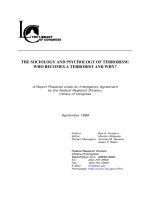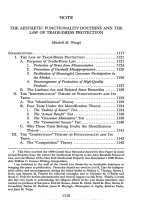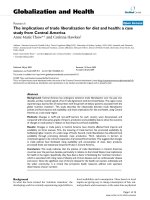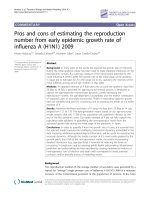The Pros and Cons of Trade Deficits and Surpluses
Bạn đang xem bản rút gọn của tài liệu. Xem và tải ngay bản đầy đủ của tài liệu tại đây (135.32 KB, 5 trang )
The Pros and Cons of Trade Deficits and Surpluses
The Pros and Cons of Trade
Deficits and Surpluses
By:
OpenStaxCollege
Because flows of trade always involve flows of financial payments, flows of
international trade are actually the same as flows of international financial capital. The
question of whether trade deficits or surpluses are good or bad for an economy is, in
economic terms, exactly the same question as whether it is a good idea for an economy
to rely on net inflows of financial capital from abroad or to make net investments of
financial capital abroad. Conventional wisdom often holds that borrowing money is
foolhardy, and that a prudent country, like a prudent person, should always rely on its
own resources. While it is certainly possible to borrow too much—as anyone with an
overloaded credit card can testify—borrowing at certain times can also make sound
economic sense. For both individuals and countries, there is no economic merit in a
policy of abstaining from participation in financial capital markets.
It makes economic sense to borrow when you are buying something with a longrun payoff; that is, when you are making an investment. For this reason, it can make
economic sense to borrow for a college education, because the education will typically
allow you to earn higher wages, and so to repay the loan and still come out ahead. It can
also make sense for a business to borrow in order to purchase a machine that will last
10 years, as long as the machine will increase output and profits by more than enough to
repay the loan. Similarly, it can make economic sense for a national economy to borrow
from abroad, as long as the money is wisely invested in ways that will tend to raise the
nation’s economic growth over time. Then, it will be possible for the national economy
to repay the borrowed money over time and still end up better off than before.
One vivid example of a country that borrowed heavily from abroad, invested wisely, and
did perfectly well is the United States during the nineteenth century. The United States
ran a trade deficit in 40 of the 45 years from 1831 to 1875, which meant that it was
importing capital from abroad over that time. However, that financial capital was, by
and large, invested in projects like railroads that brought a substantial economic payoff.
(See the following Clear It Up feature for more on this.)
1/5
The Pros and Cons of Trade Deficits and Surpluses
A more recent example along these lines is the experience of South Korea, which had
trade deficits during much of the 1970s—and so was an importer of capital over that
time. However, South Korea also had high rates of investment in physical plant and
equipment, and its economy grew rapidly. From the mid-1980s into the mid-1990s,
South Korea often had trade surpluses—that is, it was repaying its past borrowing by
sending capital abroad.
In contrast, some countries have run large trade deficits, borrowed heavily in global
capital markets, and ended up in all kinds of trouble. Two specific sorts of trouble are
worth examining. First, a borrower nation can find itself in a bind if the incoming funds
from abroad are not invested in a way that leads to increased productivity. Several of the
large economies of Latin America, including Mexico and Brazil, ran large trade deficits
and borrowed heavily from abroad in the 1970s, but the inflow of financial capital did
not boost productivity sufficiently, which meant that these countries faced enormous
troubles repaying the money borrowed when economic conditions shifted during the
1980s. Similarly, it appears that a number of African nations that borrowed foreign
funds in the 1970s and 1980s did not invest in productive economic assets. As a result,
several of those countries later faced large interest payments, with no economic growth
to show for the borrowed funds.
Are trade deficits always harmful?
For most years of the nineteenth century, U.S. imports exceeded exports and the U.S.
economy had a trade deficit. Yet the string of trade deficits did not hold back the
economy at all; instead, the trade deficits contributed to the strong economic growth that
gave the U.S. economy the highest per capita GDP in the world by around 1900.
The U.S. trade deficits meant that the U.S. economy was receiving a net inflow of
foreign capital from abroad. Much of that foreign capital flowed into two areas of
investment—railroads and public infrastructure like roads, water systems, and
schools—which were important to helping the growth of the U.S. economy.
The effect of foreign investment capital on U.S. economic growth should not be
overstated. In most years the foreign financial capital represented no more than 6–10%
of the funds used for overall physical investment in the economy. Nonetheless, the trade
deficit and the accompanying investment funds from abroad were clearly a help, not a
hindrance, to the U.S. economy in the nineteenth century.
A second “trouble” is: What happens if the foreign money flows in, and then suddenly
flows out again? This scenario was raised at the start of the chapter. In the mid-1990s,
a number of countries in East Asia—Thailand, Indonesia, Malaysia, and South
Korea—ran large trade deficits and imported capital from abroad. However, in 1997 and
1998 many foreign investors became concerned about the health of these economies,
2/5
The Pros and Cons of Trade Deficits and Surpluses
and quickly pulled their money out of stock and bond markets, real estate, and banks.
The extremely rapid departure of that foreign capital staggered the banking systems
and economies of these countries, plunging them into deep recession. We investigate
and discuss the links between international capital flows, banks, and recession in The
Impacts of Government Borrowing.
While a trade deficit is not always harmful, there is no guarantee that running a
trade surplus will bring robust economic health. For example, Germany and Japan
ran substantial trade surpluses for most of the last three decades. Regardless of their
persistent trade surpluses, both countries have experienced occasional recessions and
neither country has had especially robust annual growth in recent years. Read more
about Japan’s trade surplus in the next Clear It Up feature.
Watch this video on whether or not trade deficit is good for the economy.
The sheer size and persistence of the U.S. trade deficits and inflows of foreign capital
since the 1980s are a legitimate cause for concern. The huge U.S. economy will not be
destabilized by an outflow of international capital as easily as, say, the comparatively
tiny economies of Thailand and Indonesia were in 1997–1998. Even an economy that
is not knocked down, however, can still be shaken. American policymakers should
certainly be paying attention to those cases where a pattern of extensive and sustained
current account deficits and foreign borrowing has gone badly—if only as a cautionary
tale.
Are trade surpluses always beneficial? Considering Japan since the 1990s.
Perhaps no economy around the world is better known for its trade surpluses than
Japan. Since 1990, the size of these surpluses has often been near $100 billion per year.
When Japan’s economy was growing vigorously in the 1960s and 1970s, its large trade
surpluses were often described, especially by non-economists, as either a cause or a
result of its robust economic health. But from a standpoint of economic growth, Japan’s
economy has been teetering in and out of recession since 1990, with real GDP growth
averaging only about 1% per year, and an unemployment rate that has been creeping
higher. Clearly, a whopping trade surplus is no guarantee of economic good health.
3/5
The Pros and Cons of Trade Deficits and Surpluses
Instead, Japan’s trade surplus reflects that Japan has a very high rate of domestic
savings, more than the Japanese economy can invest domestically, and so the extra
funds are invested abroad. In Japan’s slow economy, the growth of consumption is
relatively low, which also means that consumption of imports is relatively low. Thus,
Japan’s exports continually exceed its imports, leaving the trade surplus continually
high. Recently, Japan’s trade surpluses began to deteriorate. In 2013, Japan ran a trade
deficit due to the high cost of imported oil.
Key Concepts and Summary
Trade surpluses are no guarantee of economic health, and trade deficits are no guarantee
of economic weakness. Either trade deficits or trade surpluses can work out well or
poorly, depending on whether the corresponding flows of financial capital are wisely
invested.
Self-Check Questions
For each of the following, indicate which type of government spending would justify a
budget deficit and which would not.
1.
2.
3.
4.
Increased federal spending on Medicare
Increased spending on education
Increased spending on the space program
Increased spending on airports and air traffic control
1. Increased federal spending on Medicare may not increase productivity, so a
budget deficit is not justified.
2. Increased spending on education will increase productivity and foster greater
economic growth, so a budget deficit is justified.
3. Increased spending on the space program may not increase productivity, so a
budget deficit is not justified.
4. Increased spending on airports and air traffic control will increase productivity
and foster greater economic growth, so a budget deficit is justified.
How did large trade deficits hurt the East Asian countries in the mid 1980’s? (Recall
that trade deficits are equivalent to inflows of financial capital from abroad.)
Foreign investors worried about repayment so they began to pull money out of these
countries. The money can be pulled out of stock and bond markets, real estate, and
banks.
4/5
The Pros and Cons of Trade Deficits and Surpluses
Describe a scenario in which a trade surplus benefits an economy and one in which
a trade surplus is occurring in an economy that performs poorly. What key factor or
factors are making the difference in the outcome that results from a trade surplus?
A rapidly growing trade surplus could result from a number of factors, so you would
not want to be too quick to assume a specific cause. However, if the choice is between
whether the economy is in recession or growing rapidly, the answer would have to
be recession. In a recession, demand for all goods, including imports, has declined;
however, demand for exports from other countries has not necessarily altered much, so
the result is a larger trade surplus.
Review Questions
When is a trade deficit likely to work out well for an economy? When is it likely to work
out poorly?
Does a trade surplus help to guarantee strong economic growth?
Critical Thinking Question
What is more important, a country’s current account balance or the growth of GDP?
Why?
References
Tabuchi, Hiroko. “Japan Reports a $78 Billion Trade Deficit for 2012.” The New York
Times, January 23, 2013. />
5/5









